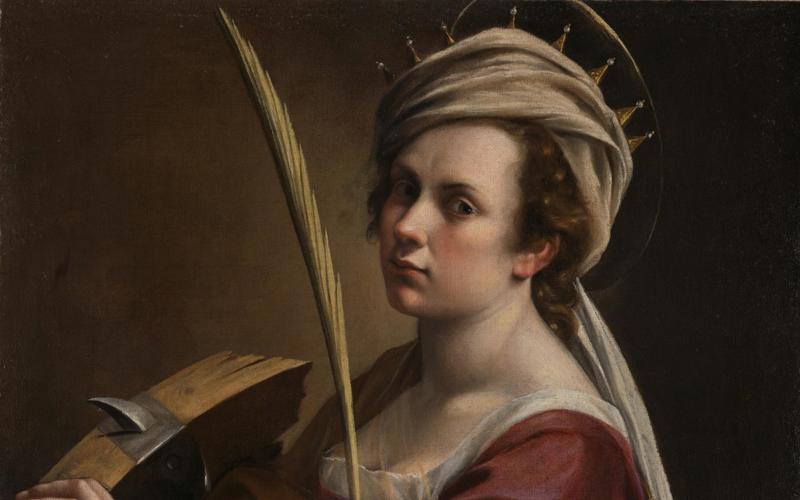Sacred stories: Saints in art
- Past - Wednesday, 3 December 2025
- Wednesday, 10 December 2025
- Wednesday, 17 December 2025
Enrol
| Standard: | £45 |
| Concessions: | £42.75 |
Please book a ticket to access the event. You will receive an E-ticket with instructions on how to access your online events, films and resources via your National Gallery account.
Please note, only one ticket can be booked per account.
Concessions are for full-time students, jobseekers, and disabled adults.
About
When you walk through the National Gallery, you find yourself among martyrs and mystics, healers and hermits, visionaries and miracle-workers. These saints were the original celebrities, with images instantly recognisable across cultures and centuries. Before they were haloed icons, saints were ordinary people who lived extraordinary lives – activists and rebels, intellectuals and mystics who advised emperors or challenged popes. Their dramatic stories challenged artists to innovate: depicting Sebastian's martyrdom required mastery of human anatomy, while visualising Francis preaching to animals prompted new approaches to narrative and space.
Through close examination of masterpieces in our collection, on this three-week course we will explore how these figures shaped both devotional practice and artistic development, discovering how their stories continue to speak to contemporary concerns about compassion, moral courage and our relationship with the natural world.

Every saint tells their story through objects. A key identifies Saint Peter, a tower signals Saint Barbara, a wheel suggests Saint Catherine. But why these particular symbols, and how did artists use them to create instant recognition across cultures and centuries? In our opening session, we will become visual detectives, learning to read the symbolic vocabulary that medieval and Renaissance artists developed to identify saints.
We will examine how a simple object – a book, a flower, an instrument of torture – could convey complex theological concepts and personal devotion. By examining famous and lesser-known works in the National Gallery Collection, we will discover how artists balanced the need for clear identification with opportunities for creative expression, and how these symbols evolved as they travelled across Europe and through the centuries.
Behind every saint lies a story – often one filled with miraculous healings, dramatic conversions, or heroic martyrdom. How did artists transform these written accounts into compelling visual narratives that could speak to both the learned and the illiterate? This week we will explore the art of Christian storytelling, examining how painters used composition, gesture, expression, and setting to make ancient stories feel immediate and relatable, and how they balanced historical accuracy with artistic licence.
From Saint George's dragon-slaying to Saint Francis receiving the stigmata, we'll uncover the techniques artists used to compress complex narratives into single, powerful images, and how these painted stories served both artistic and devotional purposes.
Christmas brought its own constellation of saints into artistic focus. This week you can expect to encounter Saint Nicholas (the original Santa Claus) and Saint Joseph as protective father, but also unexpected saints who found their way to the manger in Renaissance paintings. How did artists weave these diverse figures into the Christmas story, and what deeper meanings did their presence create?
Our final session explores how saints enriched the artistic celebration of the Nativity season. We will examine how artists used these figures to extend the Christmas narrative, provide models for Christian behaviour, and create visually rich compositions that enhanced both public and private devotion.
Your tutor:
Dr Siobhán Jolley is a specialist in the reception of the Bible in art and popular culture. She is Lecturer in Christian Studies at the University of Manchester and Visiting Lecturer in Christianity and the Arts at King’s College, London. She was previously the Howard and Roberta Ahmanson Research Fellow in Art and Religion at the National Gallery. An expert in the portrayal of Mary Magdalene, her broader research interests include the work of female artists, the reception of biblical women and the New Testament, and feminist approaches.
Watch again
Can't make Wednesday afternoons but don't want to miss out? No problem, you can watch again.
Each session is recorded and made available to you for the duration of the course, up until 2 weeks after the final session.
A video of the week's lecture will be uploaded and available for you to watch via your National Gallery account on Friday afternoons, in time for the weekend
Format
Each session lasts for 2 hours and includes a lecture delivered by the course lecturer followed by a short break and further discussion.
Time will be allowed for questions and discussion via Q&A.
Handouts will be available via your National Gallery account on Tuesday mornings.
Optional homework is provided to help you prepare for the following week's session.
Booking information
This is an online ticketed course hosted on Zoom. Please book a ticket to access the course. Only one ticket can be booked per account.
You will be emailed an E-ticket with instructions on how to access the course via your National Gallery account. All course information including your Zoom link, weekly handouts, and recordings will be available here.
Your link will be valid for the duration of the course.
Booking after the course has started
You are welcome to join the module at any point during its six-week run. You will gain access to all the recordings until two weeks after the final session.



